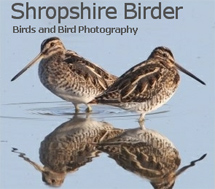Weekly round-up: 31 July - 06 August 2013
Another classic summer week.
Scorching temperatures for many, coupled with a thick blanket of sticky humidity blown along on a hairdryer warm south to south-westerly wind opened the batting this week ~ Heathrow rattling in 34 degrees C on a throbbing August 1st ~ but the inevitable breakdown followed soon after and, for some, the follow-on brought with it some sensational pelagic gold.
The warm Atlantic south-westerly airflow that sent pulses of action towards the southwest coasts of Ireland and southwest England eventually worked a course across the country ~ thunderstorms dotted around here, there and everywhere ~ but it was still warm sunshine and showers for many as fresher air eventually followed along from late on the 4th, clearing East Anglia with a flourish late on 5th.
With all that blustery, damp weather scooting in towards Cork and Cornwall, and being the time of year that it is, the signals were all pointing towards one thing and one thing only…lots of lovely rare seabirds!

“Another one-record-only species is Bulwer’s Petrel ~ the sole accepted record from Cape Clear Island was seen on August 3rd 1975."
Who’d have thought it eh? Less than 24 hours after the idle musings (the parting shot of last week’s review) on that monster pelagic star went up on the RBA website, the second record for Ireland (Britain remains on a significant size Zero) of this “most wanted” seabird would pass close inshore off Galley Head (Co. Cork) just after midday on August 1st?
Seen by three seasoned Irish birders, including Denis O’ Sullivan who’d just found the first Irish Mongolian Sand Plover just five days beforehand, the Bulwer’s Petrel Cork flyby fell just two days short of the 38th anniversary of the Cape Clear bird of August 1975.
There’s been the odd possible and probable reports of dark-rumped, long-winged petrels over the years, but there’s never really been a sniff of a real one until now. And there’s little doubting the excitement involved for the three guys present ~ but if you had a Bulwer’s Petrel passing by at around 300 metres, I guess you’d be excited too!
Goodness me, what a sight it must have been!
The individual seen in 1975 was seen by several sea-watchers during an evening scan of the seas from the famous rocky outcrop of Blanarraguan. This blast-from-the-past account, by finder Mick Alibone, tells a little bit about the sighting…
”It passed less than 200m offshore, and appeared to be loosely associated with a flock of Manx Shearwaters Puffinus puffinus moving west. Because of its long wings and apparently wholly dark plumage, I was reminded momentarily of a Sooty Shearwater P. griseus; any thoughts of the latter, however, were immediately dispelled as a Manx Shearwater appeared alongside the bird, dwarfing it appreciably.
Much larger than a Storm Petrel Hydrobates pelagicus and lacking any white rump (which had been clearly visible on Storm Petrel passing at the same distance moments previously), it remained in view for little longer than one minute, during which time good views through a 15-60X telescope were obtained before the bird finally rounded the tip of Blananarragaun and vanished in to the gloom of a slowly-clearing sea-fog, about 1km distant.”
“Shortly afterwards, accompanied by a handful of perplexed and excited observers, I returned to the island's bird observatory, where the following notes were made:”
“SIZE
Very noticeably smaller than Manx Shearwater and approximately twice that of Storm Petrel.
STRUCTURE
Shape of body and head closely resembled Storm Petrel. Very long, pointed, swept-back wings, occasionally giving impression of large Swift Apus apus. Tail distinctly long, proportionately more so than that of Storm Petrel or Manx Shearwater, appearing square-ended. Head appeared small, probably due to dwarfing effect of long wings and long tail.
PLUMAGE
Whole of head, body, upper- and under surfaces of wings and tail uniformly blackish.
BARE PARTS
Bill dark; legs and feet not seen.
FLIGHT
Strong and swift, though buoyant; wing-beats slower and deeper than those of Manx Shearwater, and general flight less direct, with erratic wandering and frequent 'jinking 'from side to side. Occasional short-distance glides with wings bowed, reminiscent of Great Shearwater P. gravis in calm weather.” Mike Alibone
Account and description reproduced by kind permission of British Birds
The tail shape was addressed by Mick in his account, noted as long, though not wedge-shaped, but then the only other possible candidate was Jouanin’s Petrel. That species’ size and range precluded it further from the discussion. Now, almost 38 years to the day, comes the second. And it’s a second for Cork too (although, as stated in Flood & Fisher “Multimedia Identification Guide…Storm-petrels & Bulwer’s Petrel” it needs to be noted that the Cape Clear bird is currently under review by the IRBC, the tail shape and length being the significant bone of contention by the sounds of it). But, for now, the Cape Clear record stands.
Staying in the Rebel County and with the Time Travelling machine still to hand, just before the big BP got a head’s up in last week’s review, these few words popped up too…
…. “still highly prized is Fea’s Petrel and the week ahead has seen four recorded.”
Despite the impressive looking deepening Atlantic low pressure that was darting in towards southwest Ireland and the extreme west of Cornwall, few could have predicted that the 100 minutes from 4pm to 5.40pm on July 31st would produce an amazing four Fea’s-type Petrels, including three at one single site in County Cork, setting an Irish record in the process too.
We’ll take a look at the three main locations that scored so well through the day, and it has to be Cork that’s the first port of call.
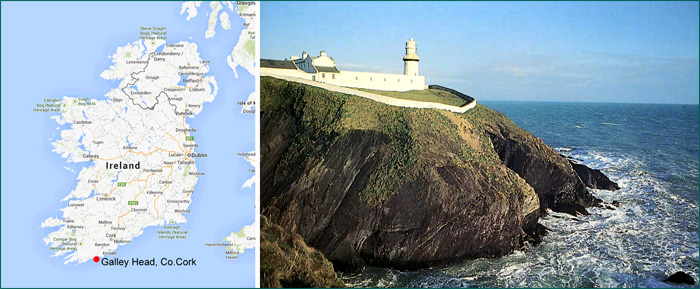
Situated to south, southeast of Clonakilty and southeast of Rosscarbery, the area near the lighthouse at Galley Head is one of Ireland’s premier seawatching sites when winds push in from the south or southwest ~ an ideal location to mop up displaced seabirds that become entangled in the sort of deep, quick-moving Atlantic low pressure systems that moved through the Western Approaches during 30th-31st.
An afternoon session from the headland during 31st made Irish birding history as an incredible three Fea’s-type Petrels were recorded ~ bird one passed by at around 4pm with the second following an hour or so later. The third made itself known 40 minutes or so after that.
But why read about this amazing day from me, sitting in Norfolk, when you can enjoy the account from the two guys who were sitting there, marvelling at what was unfolding in front of them….
Wednesday 31st July was always going to produce a good seawatch, but neither myself nor Colin could make it out earlier in the day due to work commitments. Besides, the heavens had been open all morning with sheets of rain piling down. By 1300, the conditions were looking great - the wind was a good strong south-westerly, but the mist & rain had mostly gone off, leaving a good stretch of viewable sea below the mist-obscured horizon. But both of us were still stuck in the office! Slowly the clock ticked round until a text came in from Mizen - 1,500 Cory's Shearwaters this morning - Feck! The report Colin was working on rapidly finished itself and he was off to Galley!
Soon after, I caved in too and phoned Colin to see if he fancied heading out, only to find that he was already there and had just recently picked up a Fea's-type Petrel, along with a strong passage of large shearwaters.
Cheese sandwich in hand (smoked dutch gouda, v nice) I was in the car and at Galley before you could say.....well, something that takes about 15 minutes to say....
A very smug Barton greeted me as I settled in, along with a moderate south-westerly (force 4-5) and lingering mist at about 3 miles. I put the bins up...Manx...Manx...Cory's...not too bad at all! From then until about 1830 Cory’s were passing in ones and twos every 30 seconds or so, with Great’s less frequently, all at various ranges but some very close, allowing excellent views with all features visible. Scopolis could be distinctly ruled out on many of the birds. However, the big surprise came in the shape of a second Fea's-type after only about 5 minutes - again picked up by Colin, winding its way west. I was counting my blessings that I hadn’t spent that few minutes trying to find my waterproofs before heading out! Good views were obtained in the mid distance, the bird even landing on the water briefly. Unusually, this bird showed a very distinctly pale (brown) collar on the hindneck, making it quite distinct from the bird Colin had seen earlier. To my mind this was also a slightly smaller and slightly slimmer winged bird than the few other Fea's I've seen.
On a high, we continued to enjoy what was one of the best seawatches I've ever had - with Long tailed Skuas passing, along with the other skua species. Three Poms just off the rocks were impressive, along with the continuing passage of large shear’s.
The icing on the cake came 45 minutes later though, as 'Soft lad' Barton picked up a third Fea's-type coming in from the east. A bit closer, this bird also gave great views as it whizzed its way west. Yet again however, this bird showed a distinct plumage difference from the other two, being very extensively white around the face (visible at all angles).
Not believing our luck the rest of the seawatch was a blur. Activity began to tail off after about 1830.
These records are particularly interesting as it has often been suggested (including by myself) that seabirds may be doing large circuits off the Galley Head area rather than just passing west as is usually assumed. I still think that this may be the case in certain instances, and had the 3 Fea's not been individually identifiable it may have added weight to the argument? There are often significant differences in the composition of seabird species and numbers passing the Old Head of Kinsale, Galley Head, Cape Clear and Mizen Head, even when being watched simultaneously. However, it was established that the 3 birds were different individuals. Unusually, there were no Storm Petrels seen on the seawatch, despite the lads at Mizen picking up a Wilson’s among their excellent haul.
Coming just days after Denis O Sullivans amazing Mongolian Plover find (well done Denis!!) this has turned out to be quite a week following a long dull spell. Of course, the events of the following day put a new light on even our fantastic day (Well done Paul, Denis and Alec!). Ciaran Cronin & Colin Barton
Galley Head is located in West Cork, in the south-west of Ireland, just over an hour from Cork City. There is no public access to the lighthouse.
Keep up with the latest from Galley Head on the blog: http://galleyheadbirding.blogspot.ie
Along with all the excitement of a hat-trick of Fea’s Ciaran and Colin also managed to log 250 Cory’s Shearwaters, 53 Great Shearwaters, along with the 5 Long-tailed Skuas and 7 Pomarine Skuas mentioned.
Up until the end of 2011, Cork had already recorded an astonishing 34 birds ~ split across six different sites. Galley Head leads with 12 birds (the first in 1991, the most recent accepted bird in 2009), with Cape Clear Island a close second (until this week) with 11, including Ireland’s first in September 1974. Five birds, including two on the same seawatch on August 24th 1994, have been recorded off Mizen Head, while the Old Head of Kinsale has four. Single Fea’s-types have also been seen from Dunowen Head (in 2008) and Seven Hands (in 2011).
The overall total of accepted Fea’s-type Petrels for Britain and Ireland is just shy of 130 (up until the end of 2011) and the only “double days” have been as follows….
Flamborough Head, East Yorkshire on September 6th 1991
Mizen Head, County Cork on August 24th 1994 (as mentioned above)
Bridges of Ross, County Clare on August 25th 2007
Galley Head takes the top spot as of now and it seems like that was one seawatch that could be tough to top…
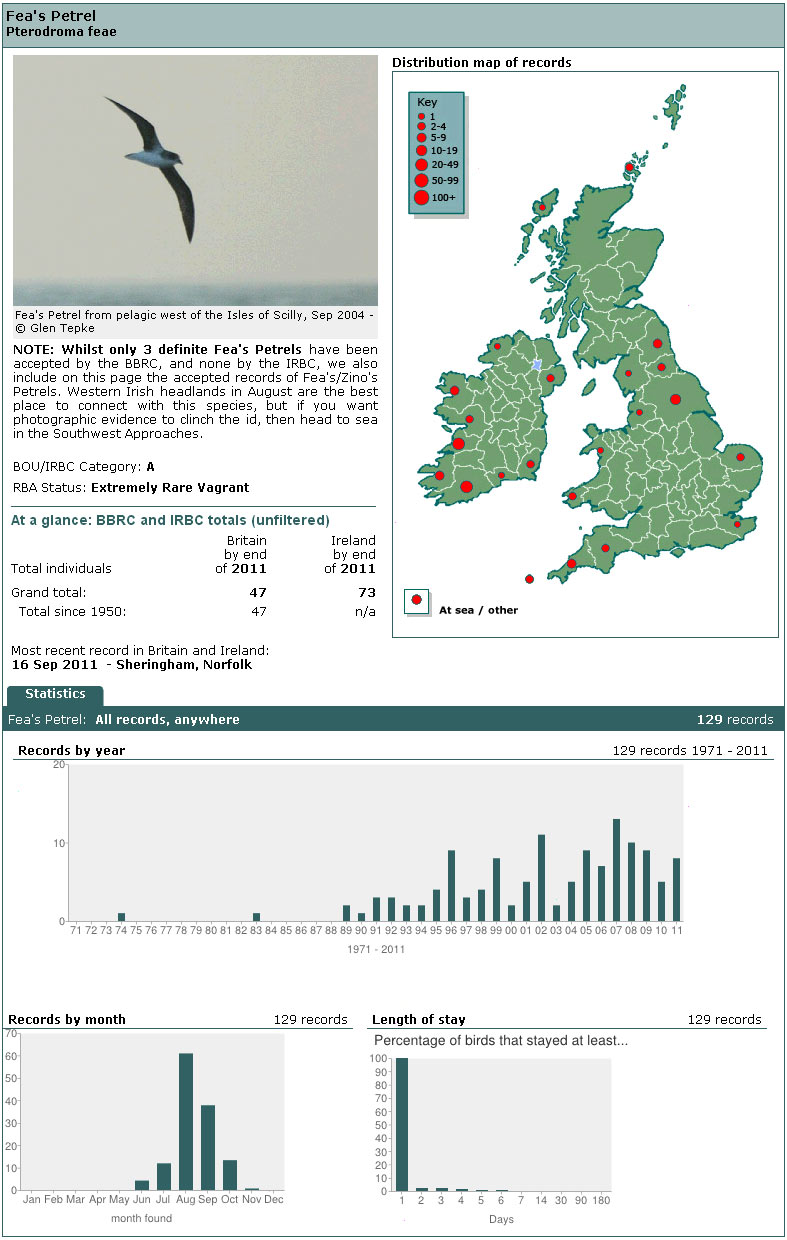
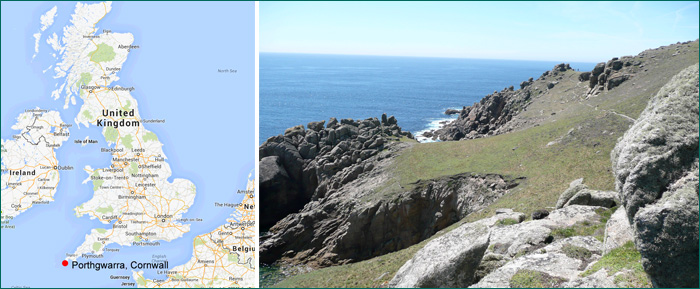
This famous Cornish site has long drawn birders to the far west of the country to chance their arm in the optimum conditions of southwesterly winds and clearing showers and squalls. It can be tough on the top at Gwennap Head but you can definitely reap the rewards…
Just as Galley Head was notching up the third Fea’s Petrel of the day, Porthgwarra clocked up the fourth bird of the day, at around 5.40pm. To go along with that, birders present through the day had also notched up 4 Cory’s Shearwaters, 24 Great Shearwaters and 23 Balearic Shearwaters, along with a few Sooty Shearwaters, British Storm-petrels and Puffins too.
Porthgwarra was the first site in the southwest of England to record Fea’s Petrel ~ the first was, famously, seen on three consecutive days in August 1989 (12th-14th) and, at present, remains the only site on the Cornish mainland to have recorded the species at all, including another bird that was presumed to have been the same one over the course of four days…
…and then, on 1st, another (?) Fea’s Petrel was reported, this one passing Gwennap Head just before 4pm. Is history repeating itself with a multiple day looper? Well maybe, as a Fea’s Petrel headed past the site again on the morning of 4th ~ a look at the weather maps would have suggested (to anyone willing to give it a go) that PG was a good bet for the species that day…fair play to those who took the gamble and rolled the dice.
Brian Mellow, who has spent many thousands of hours sea-watching in Cornwall got his just rewards with a self-found Fea's and a 'Curnish' tick to boot! Here is a brief account from Brian about his find...
I picked up Royston Wilkins at 0515hrs and we made our way to Porthgwarra, chatting on the way about the weather forecast which was Rain. We arrived at 0600hrs and made our way to the seawatching spot only to find about 20 birders had beaten us to it. However apart from several showers the visibillity was good and there was a Southwesterly wind blowing force .4-6 which is perfect conditions for seeing large Shearwaters.
It wasn’t long before a Great Shearwater came into view shearing along the race caused by the rocks which the Runnel Stone marks, then another flew west, then a Cory’s, it was obvious it was going to be a good day. We were all talking about what seabirds had been seen off Ireland with three Fea’s seen from one location. It was then that Royston recounted the time when he left Porthgwarra at 0900hrs only for a Fea’s to fly by 10 minutes later.
Then while scanning the sea a good way left of the watchpoint I picked up a bird that was pale grey above with a black underwing and a white belly. I shouted FEA’S Petrel and panic set in for the now 29 birders present, The bird had a high arcing flight reminding me of the bird I had seen from the Scillonian. In about a minute the bird was under the Runnel Stone bouy, giving those who had not picked it up a last chance to get on it.
After the bird had passed it was high fives all round for the 28 birders who had seen it and when I looked at my watch the time was ten minutes past nine how spooky is that.
The accepted Porthgwarra records to date are…
August 12th-14th 1989
June 11th 1996
August 26th 1999
August 25th 2008
August 30th – September 2nd 2009
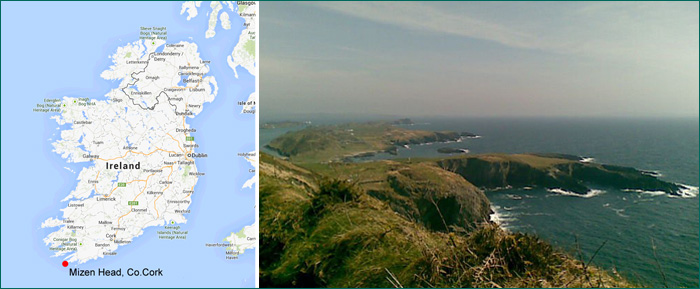
Nestled at the far southwestern tip of County Cork, Mizen Head is another of Ireland’s prime birding spots ~ either for searching out passerines or taking a punt on a seawatch or two.
Just two birders took up the challenge of a seawatch on July 31st and, although they didn’t log any Pterodromas, they still managed an outstanding set of birds.
Although “rarer” species were noted on the day, the most eye-catching figure was the 2,500 Cory’s Shearwaters counted between 11am and 7.30pm ~ an average of just under 300 an hour. Four figure counts of this elegant big shearwater don’t come around too often and it is a number that definitely makes you sit up and take notice.
Also in the mix off Mizen, 120 Great Shearwaters, 2 Long-tailed Skuas, 3 Pomarine Skuas and, best of all, a Wilson’s Storm-petrel.
The species has long departed the Rarities List in Britain (coming off in 2005, when over 340 had been recorded). In Ireland, Wilson’s Storm-petrel records are still a big target bird for seawatchers and, until the end of 2011, Cork had 26 records, of 40 birds, on the books including 10 seen off Galley Head on July 18th 2010.
Mizen Head’s only Wilson’s to date was recorded on August 24th 2001. To date, nine Irish counties have accepted birds on their respective lists, from counties Down and Antrim, around to Donegal and (remarkably) Fermanagh. Mayo, Galway and Kerry also pop up (the latter with 22) but none of them touch County Clare’s tally of 59 records (involving 125 birds, including the incredible day tally of 27 from Bridges on August 1st 2009). Indeed, all bar two of Clare’s records have come from one of Europe’s premier seawatching hotspots.
Keeping the tempo at a pretty high rate (and then some) came the unusual double Mega hit from Devon’s Start Point on 4th. Bird one was a Yelkouan Shearwater, seen passing by just before midday. Bird two was a Barolo Little Shearwater noted heading southwest at teatime.
The current status of Yelkouan Shearwater was discussed in the review of June 19th-25th, detailing in particular the record currently at BOURC of the photographed Yelkouan (or Menorcan Shearwater) seen from Berry Head in July 2008. Limboland lies ahead for that outstanding individual and at least one or two other well documented records on the files….
Barolo Little Shearwater is an altogether different beast ~ admitted to the Irish list after a record of a bird on board a sloop off County Cork in 1853 and added to the British list following the discovery of a dead male near Earsham in Norfolk in April 1858. By the end of 2011, there have been 63 birds accepted birds logged in Britain with 22 for Ireland.
This makes Barolo Little Shearwater considerably rarer than Fea’s Petrel (120 individuals for them, all bar two coming from 1989 onwards) and gross-rares aside, it remains one of the hardest seabirds for birders to connect with. Many more may have been claimed of course, but Little Shearwater is a species that always struggles at committee level and always will.
To date, Devon’s only accepted record of Barolo Little Shearwater is the returning singing male found on Lundy in the spring and summers of 2010 and 2011.
Interestingly, there have been five records of two birds in a day ~ one of those was from South Stack on September 15th 1987 and they came just a few days after an astounding four birds were accepted for the same site, on September 12th. The only other eyebrow raising single-day multiple is the three birds accepted from Flamborough Head on October 1st 1978. It would be fascinating to see how records like these would fare nowadays…
..so, that’s the end of the Headline Acts. All of them seabirds….fancy a few more? Okey dokey. Here ya go…
Since we started our weekly round-ups head warden on Fair Isle David Parnaby and the rest of the Fair Isle Bird Obs team have contributed tremendously with photos and accounts of some great birds. So it was somewhat bittersweet to have to include David's account of the Swinhoe's Petrel in last week's round-up. Although I was hopeful when I wrote the following "Fingers crossed that maybe, just maybe, David strikes it lucky when he returns to the island..." I have to admit I thought that the chances of them re-trapping the same bird were very slim indeed. What then were the chances of him returning only to trap a new Swinhoe's Petrel? Pretty damn small I reckon! Well nothing gives me greater pleasure than to be able to include the following text and photos from David's excellent nlog detailing this extraordinary event, the excitment and joy is obvious and reminds us all of the thrill of see the one you thought had got away. Well done David on one of the all time great 'grip-backs'!
As you all know, I’m a purist when it comes to my list and the fact that I’d only heard a Swinhoe’s Petrel last month meant I couldn’t count it (even though what was presumed to be the same bird was trapped a few days later, by which time I’d left the island to visit my family in Sunderland). I’m pretty sure that’s what I wrote last time anyway.
However, the fact that I’m writing a blog update at 5am may give you a clue to where this story is going…

Since the bird was caught on 27th July, Seabird Officer Will Miles and the rest of the team have kept up an almost constant effort on Storm Petrel ringing in the hope of a ‘Tynemouth style’ repeat visit. As the days ticked on, hopes were perhaps fading slightly, although with catches of up to 100 Stormies in a night and a record annual total of 16 Leach’s Petrels ringed it was still a very enjoyable way to spend our time. Not everyone had given up hope though; top Shetland birder Dennis Coutts decided to pop in for a couple of nights this week, on the off chance the Swinhoe’s put in a repeat appearance…
Conditions in the early hours of this morning seemed pretty good, with thick cloud cover and virtually no wind (although a minor technical glitch that saw the generators chuntering away and then a sheep stampede threatened to derail events somewhat). The fact that the first Storm Petrel hit the nets before the tape was switched on backed up our suspicions that we were in for a good night and by 2 o’clock we’d caught around 70 Storm Petrels (including two ringed in Portugal and one in Denmark) and heard two Leach’s Petrels.

Logan Johnson, visiting from Yell had just taken a couple of Storm Petrels out to be released when he wandered back into where I was ringing and said ‘Swinhoe’s Petrel’, before repeating it three times. By this point I could hear Will yelling from the net and things started to sink in. I dashed out to the net, where Will had just extracted a dark-rumped petrel. A quick check in the light revealed all the relevant features and also confirmed what Will had said at the nets, ‘it’s a Swinhoe’s, but it’s an unringed one!’. The Obs machine went into full effect again and there was quickly a small crowd gathered in the ringing room for the remarkable sight of our second Swinhoe’s Petrel of the year.
We’d suggested that Swinhoe’s Petrels in the North Atlantic seemed to arrive in ‘waves’ associated with warmer summers, but I’d thought that the surge of Stormy ringing around the UK coast that the first Swinhoe’s caused would mean another site may cash in on this amazing vagrant – not that we’d get a second!

Fair Isle certainly delivers all sorts of exciting birding, but this is more than I could have hoped for. Whether it is the end of the Swinhoe’s story for Fair Isle remains to be seen (remember those returning Tynemouth birds), but for tonight, I’m extremely happy with my lot.
David Parnaby
With all the major excitement centred around what was passing the coast of Cork, eyes were, inevitably, drawn to what could be expected (or wished for) in the far southwest of England and with a Scilly pelagic setting out on the evening of 1st, there were a few people wondering just what could pop up on that particular voyage…
…as it turned out, the “big bird” didn’t appear (the weather was definitely more favourable to the northwest of Scilly), but there was a superb looking Wilson’s Storm-petrel by way of significant compensation ~ and once again MV Sapphire’s skipper Joe Pender was on hand to capture two stunning images of a particularly fine looking bird. Also on 1st came another Wilson’s, noted 100 miles or so to the west of Mizen Head.
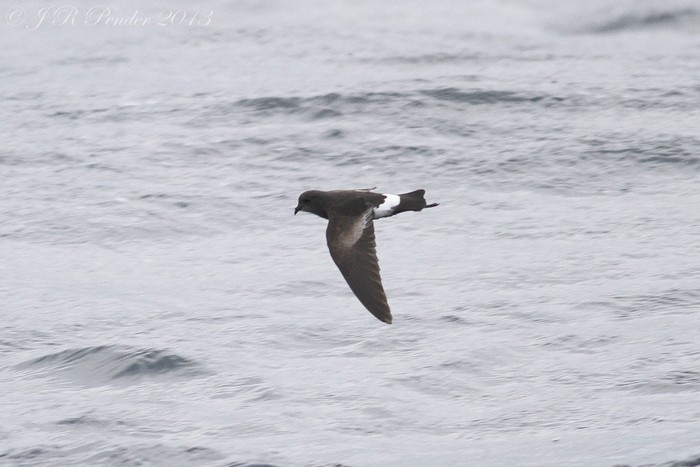
A probable Yelkouan Shearwater was seen from Porthgwarra, also on 1st with another noted from Galley Head during a seawatch there on 3rd.
Further big shearwater records included two Cory’s off St. Ives Island on 31st with three from the Old Head of Kinsale and one off Galley Head on 1st, when one was also noted through the Minch, between Tarbert and Uig, in the Outer Hebrides and another headed by Kerry Head (Co. Kerry). A few more followed across a breezy weekend of 3rd-4th, including 16 off Porthgwarra on 4th with 14 were seen way beyond Mizen Head (some 90 miles or so) and five off St. Mary’s (Scilly) on the same date.

Additional Great Shearwaters on 1st were 17 seen from Galley Head and six at the Old Head of Kinsale, with one off Porthgwarra. A handful of ones and twos were noted between 2nd-3rd (in Cornwall or off Scilly) and one was further along the English Channel on 4th, passing Devon’s Berry Head with two from Start Point as well. Back in Cornwall, seven were counted off the Lizard, also on 4th and three (along with a couple of Cory’s) were noted off Berry Head on 5th.
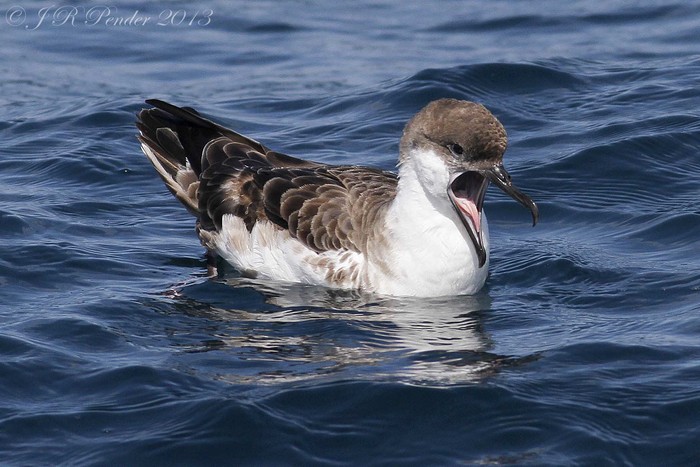
However, it was the seawatchers at Porthgwarra who fared best, not only had they bagged a Fea’s-types and a few Cory’s, they also managed 47 Greats as well to add to a very pleasing haul for a busy August 4th.
Other oddments this week in the world of Pelagic Pleasers included additional Long-tailed Skuas to those already mentioned off Portland Bill (Dorset) and the Lizard (Cornwall) on 31st, St. Mary’s Island (Northumberland) on 1st, Kerry’s Kerry Head on 2nd and two more for Galley Head on 3rd. Twelve more Pomarine Skuas were seen between 31st-3rd (in three Irish, five English and one Scottish county) and a Grey Phalarope appeared at Sandbanks, Poole Harbour (right next to ‘arry’s house?) on 1st.
Some pretty respectable daily figures were logged for Balearic Shearwaters through a pretty blustery week ~ on 31st at least 89 were logged (almost entirely in the southwest, as was the case for the rest of the week) and included 23 from Porthgwarra and 24 for Portland Bill. The former site produced 31 the following day (in an overall day tally of 42), with 2nd yielding 183 in all, with 100 from Devon’s Start Point easily the most significant count of the day. Numbers maintained a decent figure on 3rd, 90 birds recorded, with 25 from Porthgwarra and 15 from a “Penzance pelagic” the highest totals noted.

Once again it was the 4th that saw the big scores chalked up on the Balearic blackboard ~ Start Point’s seawatchers fared best with 255, while 190 were seen off nearby Prawle Point. Porthgwarra yielded 65 while Berry Head managed 45, with over 60 there on 5th with a further 80 from Start on 5th as well.
Finally, a Sabine’s Gull flew past Helvick Head (Co. Waterford) on 1st and another was seen from the same boat 115 miles off Mizen Head on 2nd.
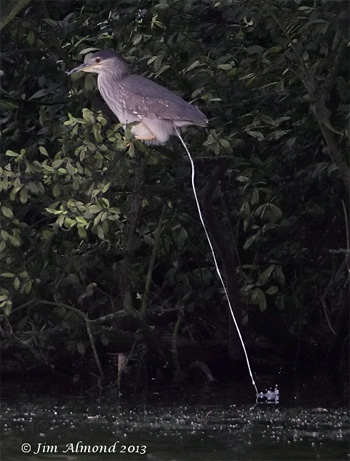
Great news from the Somerset Levels this week where, to the sound of cider corks popping, there was confirmation that a pair of Little Bitterns have raised at least one juvenile to fledging ~ four birds, two males, a female and a youngster, were seen at Ham Wall RSPB on 1st with one of each noted on 3rd.
Successful breeding was noted in the area in 2010 (at least one juvenile seen) and followed on from a territorial, singing male throughout much of the spring and summer of 2009. Breeding was suspected in 2011 (but not proven) and in 2012, the birds were back on track ~ juveniles noted, along with two nests, perhaps from the same pair.
In Leicestershire, a first-summer Night Heron at Thornton Reservoir proved to be a particularly popular draw for birders from 31st (having been present for a few days beforehand and thought, at one point, to perhaps be a Little Bittern). The bird often showed well and was still showing to 6th. The second Night Heron of the week continued to show at Old Moor RSPB (South Yorkshire) through until 4th.
A Purple Heron was seen at Pagham Harbour (West Sussex) on 4th, heading off to the west, while the only Cattle Egret recorded this week continued to flit across the Kentish countryside, between Oare Marshes and Elmley, to 5th at least. The same date saw the most recent update for the resident Glossy Ibis at Marloes Mere (Pembrokeshire).
The week began with a whopping 14 Great White Egrets on 31st ~ but nine of them were together at Shapwick Heath NNR in Somerset, numbers swollen by some home-grown juveniles ~ while birds left over from the previous review remained at Dungeness, both Fen Drayton RSPB and Wicken Fen NT in Cambridgeshire and Clifford Hill GPs in Northamptonshire while new was one in flight near Roxwell (Essex).
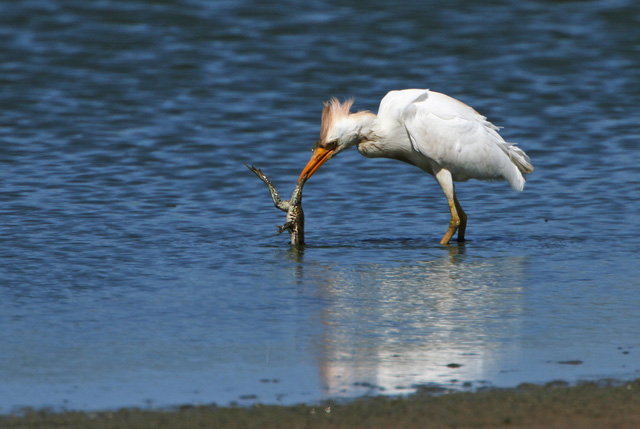
Night Heron watchers in Leicestershire enjoyed the added bonus of a Great White Egret on 1st-2nd while further stickers included birds in South Yorkshire, in the Dearne valley to 2nd (a bird at Orgreave on the same date may have been different) and on the Isle of Wight, still at Brading to 4th. More new individuals were seen at Misson (Nottinghamshire) on 3rd and at Berrow (Somerset) and Llyn Coed-y-dinas and Dolydd Hafren MWT, both near Welshpool (Powys) on 4th.
Spoonbill numbers fell away a little bit along the Norfolk coast this week, although there was still one double figure gathering, 12 present on Stiffkey Fen on 3rd. Titchwell peaked at seven (on 31st), while five at Cley on 4th (including four juveniles with assorted bill lengths).
Two birds were noted heading over Huttoft Bank (Lincolnshire) on 3rd while the other nine records this week were all of single birds ~ noted from Thurlestone in Devon, through Slimbridge WWT and the National Wetlands Centre in Carmarthenshire, out to Kent and Essex (singles at Dungeness, Old Hall Marshes and then Abberton Reservoir) through South Yorkshire and on to Northumberland, two loners noted, one still at Budle Bay with another to the north, along the River Tweed on 4th.
In the far west of Norfolk, three Common Cranes remained at Welney WWT (Norfolk) for much of the week, while at the far eastern end of the county, two were noted over Martham Broad on 3rd and five performed a flypast over the Roller fields at Horsey on 5th.
Back in Northumberland, a juvenile Spotted Crake was found in the reedbed at East Chevington NWT on 31st, where it showed until 3rd and a second appeared at Wellington GPs (Herefordshire) on 5th, where it remained to the following day.
The “Interesting Duck of the Week” award goes to the one day only Marbled Duck seen on the River Dee, near Kirkcudbright (Dumfries & Galloway) on 3rd.
Still not on the British List and unlikely to be any time soon after the isotype analysis of a reported first-winter shot in Essex in September 2007 didn’t support vagrancy (for that bird).
Interestingly there were never any photos of the dead bird in the paper and little to explain exactly how the bird was aged as a first-winter…) but there have been numerous excellent contenders over the years (individuals at Saul Warth, Kelling Water Meadows, Stanpit and the Minsmere pair in more recent times, heading all the way back to the much-twitched bird at Chew in the early 1980’s and more besides). Whether the D&G bird from this week falls in to the same esteemed company is one for further debate…
Far less problematic was the still-present Black Duck on the estuary at Ballylongford (Co. Kerry) (in place to 5th) and the newly arrived eclipse drake Blue-winged Teal on the Ouse Washes RSPB (Cambridgeshire) from 3rd-5th for what will be the 10th record for the county and the fourth record for the site).
The summering drake Ring-necked Duck at Brompton-on-Swale (North Yorkshire) remained to 4th at least, with the female on Lough Beg, at Mullagh (Co. Derry) was still in situ to the same date.
Aberdeenshire was host to the only Surf Scoter of the week, a first-summer drake still off Blackdog on 3rd.
A new, rather dandy, adult summer Long-billed Dowitcher was found in Hampshire this week, at Pennington Marshes, from around the 1st and was still in place on 6th ~ potentially the ninth county record.
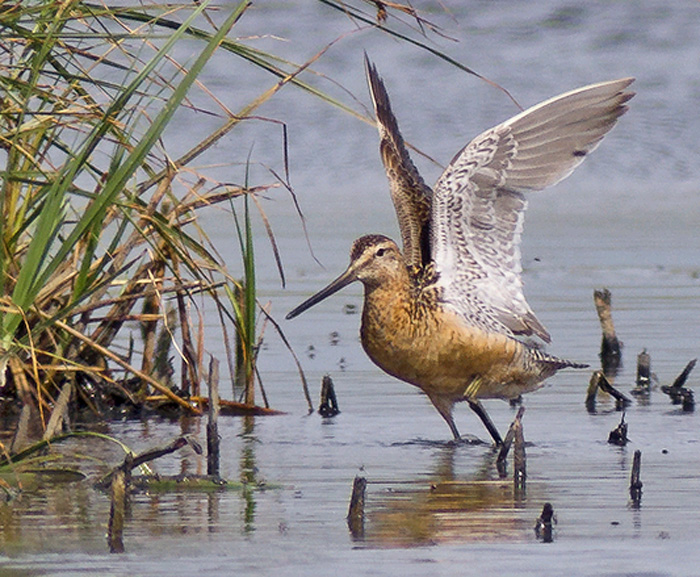
Last week’s Long-billed Dowitcher at the National Wetlands Centre WWT in Carmarthenshire was last seen on 1st while the Lesser Yellowlegs reappeared there on 1st (having last been seen there on July 29th). This time around the bird stayed to 4th at least.
Wexford was the new home for a White-rumped Sandpiper (at Seafield on 4th with it, or another, popping up at Tacumshin on 6th) and also two adult Buff-breasted Sandpipers on 4th at, wait for it….Tacumshin (where else?!?). The same site was also the host with the most for a moulting adult Red-necked Phalarope on 2nd.


A summer adult American Golden Plover flew south at Spurn on 5th while nipping in ahead of the Tac twosome was a lone Buff-breast at Elmley NNR, present on 3rd-5th while Pectoral Sandpipers ended up with 10 birds this week, some of which were leftover from the last review.
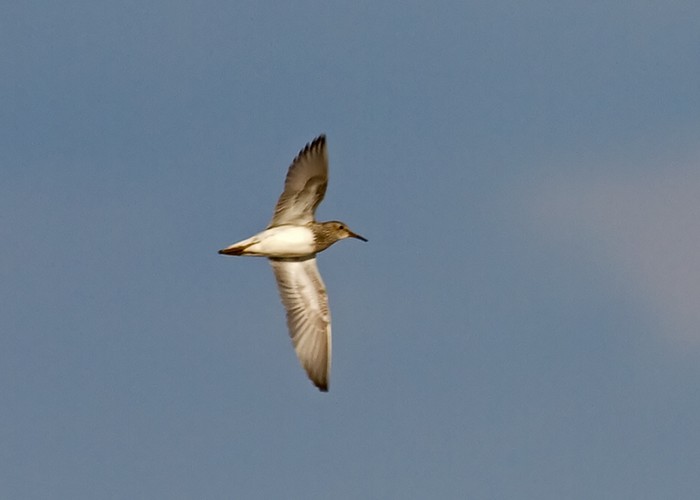
These included singles at the Axe Estuary (Devon), Newport Wetlands (Gwent) and Pennington Marshes (Hampshire) while new arrivals were noted as follows:- on 31st one arrived at Pulborough Brooks (West Sussex), on 1st singles were found at Burton Mere Wetlands RSPB (Cheshire) and Frampton Marsh RSPB (Lincolnshire) and on 4th at Eton Wick (Berkshire), in Aberdeenshire at both Meikle Loch and Loch of Strathbeg and over in Ireland, one was found at Ring Marsh.
Back at Tacumshin, a Gull-billed Tern was found on 4th, two weeks or so since the last of the duo that arrived on July 3rd was seen while on Shetland, at Scatness, the obliging third for the islands remained to 31st.
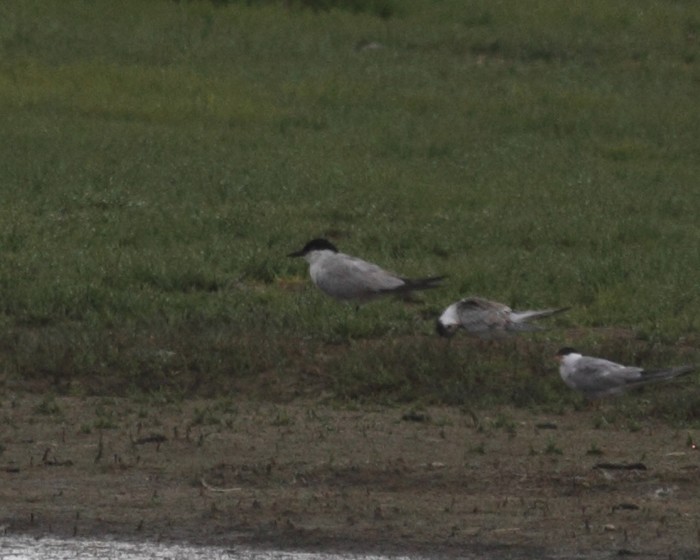
A Caspian Tern flew close inshore past St. Margaret’s at Cliffe (Kent) on 5th ~ the 23rd record for the county but the first since one was seen on Oare marshes in July 1999.
Lincolnshire’s run on presumed first-summer Baltic Gulls continued in the fields near Brigg (Lincolnshire) at the start of the week ~ two birds present (one of them another new one, the third in all in the area in just a few days) ~ while an arguably more interesting first-summer (in a sub-Heuglin’s styleee) was at North Hykeham, also in Lincolnshire, also on 31st.
The two Bonaparte’s Gulls noted in recent weeks remained for a few more days ~ the semi-resident first-summer bird at Oare Marshes NR (Kent) was around for another week and the adult at Heysham (Lancashire) appeared to done a bunk after 3rd but then reappeared there on 6th.
In Wales, a Ring-billed Gull was reported from the car park at Laugharne (Carmarthenshire) on 1st (having been present for at least a couple of days), while four birds appeared around Ireland ~ two were seen in County Kerry on 4th, at Reenard Point and Blennerville, while in County Louth one was seen east of Dundalk, at Gyles Quay on 3rd when one was noted again at Nimmo’s Pier (Co. Galway).
Also at Nimmo’s was an Iceland Gull while the summering second-year Glaucous Gull remained at Helvick Head (Co. Waterford) to 4th.
A male Red-footed Falcon was something of a surprise at Langdale End, near Scarborough (North Yorkshire) on the afternoon of 4th while in southwest England, a Black Kite was again noted trundling about the far west of Cornwall ~ first seen at Porthgwarra on 2nd, what was probably the same bird then appeared at Nine Stones the following day, heading on to Carbis Bay on 4th.
In Kent, a Black Kite was over Cliffe Pools on 31st and another was reported from Margate on 5th. Another was also reported over Upper Lyde in Herefordshire on 3rd.
Four Honey Buzzards were reported this week, including one again from the Welbeck Raptor Watchpoint (Nottinghamshire) on 4th, while Norfolk’s probable dark morph Booted Eagle was seen again on 1st, again not too far away from Holt, drifting from Edgefield Green towards Plumstead.
Earlier in the year, a rather more obliging rarity from the Med gave itself up in rather more accomdating fashion compared to the Booted Eagle ~ that bird was the Roller and it lingered near Holt Lowes from June 16th-19th. That very popular bird was the first in Norfolk for 22 years (following on from the one-day bird at Holkham in July 1991) and now, double-decker bus like, Norfolk has a second within just a few weeks…
Bird 2 ~ it is thought to be a little brighter than the Holt bird around the face for instance ~ was a very pleasant Monday lunchtime surprise when found along the fenceline to the south of the Nelson’s Head track at Horsey. Performing well throughout the day (heading off to roost around 7.30pm), the bird attracted a modest crowd and maintained station in the same area on 6th too. This new arrival means that 2013 has become the first year since 1976 to have seen two Rollers noted in Norfolk in the same 12 month period (birds then were seen at Hilborough and Upton Fen).
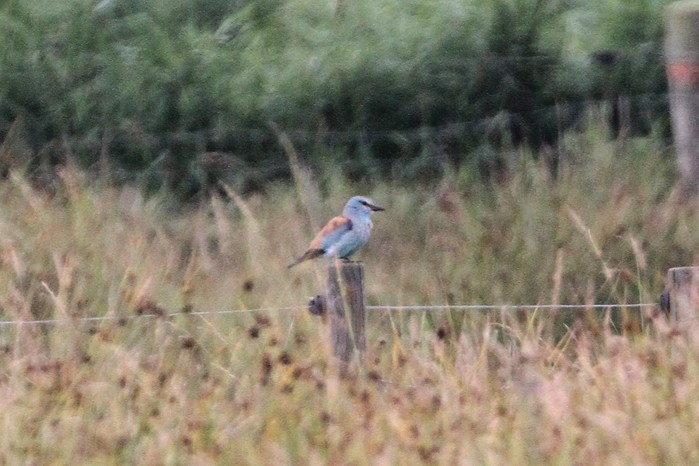
Another surprise this week was the Alpine Swift that headed south over Gibraltar Point (Lincolnshire) on 3rd with maybe the same bird heading over Spurn the next day, while further off to the north, the male Western Subalpine Warbler was still at Schoolton, Fair Isle to 4th and the Marsh Warbler made it to the first day of August.
Still in the Scottish islands, this time over on Skye, an adult Rose-coloured Starling was at Broadford on 31st. More colour came along on 6th when two early morning Bee-eaters were found over Whitburn (Co. Durham).
To balance things out a bit ~ the headline birds have been somewhat top-heavy over pretty much everything else in recent weeks ~ we’ll bring the curtain down on this week’s proceedings with the latest on the entertaining Two-barred Crossbill invasion.
Now in to week three, Shetland’s dominance Two-barred Crossbill continued this week ~ two flocks of seven birds leading the way. Last week’s group of five at Loch of Voe nudged up by two on 31st while on Fair Isle, seven of the eight found on Hoini a few days ago remained to August 1st (with four there on 3rd) ~ the two males still in the thick of it too.
Two birds remained at Tresta and singles remained at Sumburgh Head and out at sea, still some 45 miles to the west of the islands on 31st. Four juveniles remained at Loch of Voe on 1st when two new females were found at Halligarth on Unst, where one of last week’s juveniles remained at Baltasound to the same date. One reappeared at Setter, Sandwick on 4th, and two new birds were found at Hamar, Unst on 6th.
On Orkney, near Stromness, the male and female Two-barred Crossbill remained to 2nd with the former still in place on 3rd.
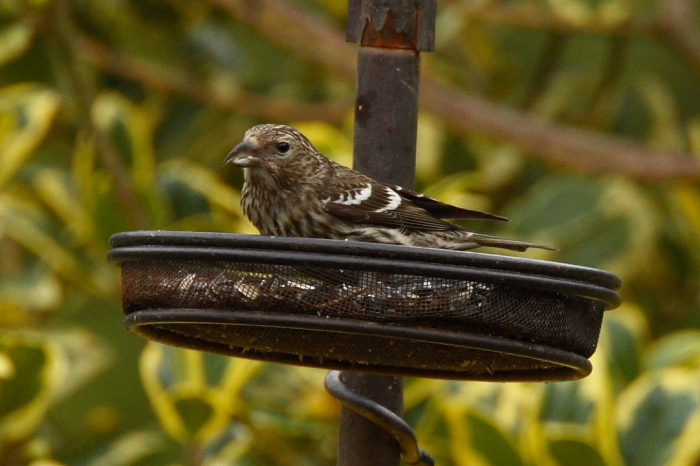
Several hundred miles to the south, in Redlands Wood near Dorking (Surrey) a female Two-barred Crossbill was found amongst a group of some 150 Common Crossbills on 31st ~ the first record in the county since a male was at Frensham for almost a month in late September 1966. Four birds were at a withheld locality in March 1948 with the other country records falling between 1889 to 1900. Have any other birds from the current irruption pushed as far to the south? Time will tell…
What we do know is that at least one juvenile Two-barred Crossbill pushed in to the northwest of England ~ Lancashire’s first county record appearing on the feeders at Browsholme Farm, near Clitheroe on 2nd, where it stayed until 5th. Previously there have been records of the species to the north (five records for Cumbria) and to the south (including one in Cheshire) but this will have been a most welcome addition to the Lancs. list.
Back in Scotland, a juvenile was found in Roseisle Forest, south of Burghead, which is just the second record for Moray, following the first back in April 1973.
The old Predictoromter has been waggling in the right direction of late, but it will doubtless all come to an end from here...
Much of the attention is, once again, grabbed by a lovely wide variety of rare sea- and shorebirds, but there are a couple of other things that really catch the eye...
Britain’s first Eleonora’s Falcon spent two days at Formby Pint (Lancashire) on August 8th-9th 1977 ~ still the only two day bird but, like the other six accepted records, not twitchable ~ while the long-forgotten Rufous Bush Chat made its last appearance on August 9th 1980 at Prawle Point. Another British first, Ruppell’s Warbler, was uncovered on Shetland on August 13th 1977 (two firsts within less than a week!) but perhaps the most eye-catching thing of all on the books remains the legendary Nutcracker invasion of 1968.
The first birds arrived in Norfolk on August 6th 1968 and between 7th-14th a further 17 appeared, the majority in Norfolk, but with others in Suffolk and also in Kent. And that was just the tip of the iceberg...in the days, weeks and months that followed a staggering 262 records were notched up, including numerous multiples, with small flocks of up to six birds noted.
Andy Stoddart takes hold of the reins for the next couple of weeks. Here’s hoping he has a busy time!
Mark Golley
31 July 2013
Thanks also to the rest of this week's contributors for their photos and videos.










